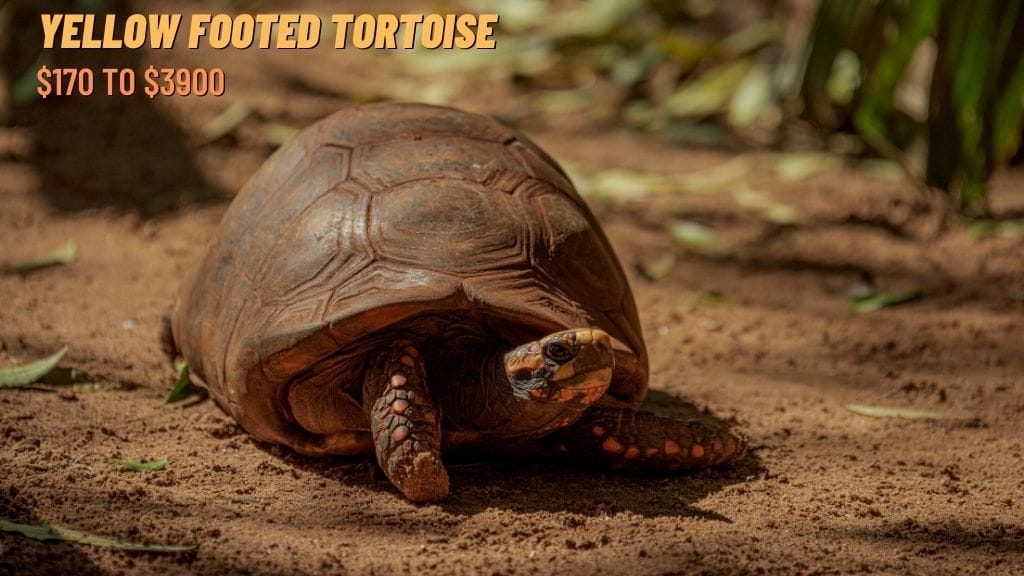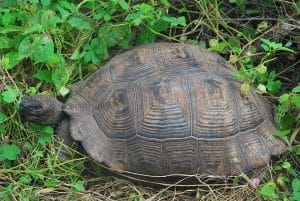Chelonoidis denticulatus (Yellow-footed Tortoise)
Home > Turtle Database > Chelonoidis denticulatus (Yellow-footed Tortoise)

Chelonoidis denticulatus, commonly known as the Yellow-footed Tortoise, is a large terrestrial species native to South America. It is well known for its distinctive yellow scales on its limbs and head, which contrast with its dark, dome-shaped carapace. This species is primarily found in humid tropical forests and is known for its slow movement and herbivorous diet.
Native To These Regions
Acre (Brazil), Amapá (Brazil), Amazon (Ecuador), Amazonas (Brazil), Amazonas (Venezuela), Bolívar (Venezuela), Bolivia, Colombia, French Guiana, Guyana, Maranhão (Brazil), Mato Grosso (Brazil), Pará (Brazil), Peru, Rondônia (Brazil), Roraima (Brazil), SurinameNative Turtle Species Map – Find Turtles by Region
Scientific Classification
Kingdom: Animalia
Phylum: Chordata
Class: Reptilia
Order: Testudines
Family: Testudinidae
Genus: Chelonoidis
Species: Chelonoidis denticulatus
Common Names
- Yellow-footed Tortoise
- South American Yellow-footed Tortoise
- Brazilian Giant Tortoise
This Hilarious Turtle Book Might Know Your Pet Better Than You Do
Let’s be real—most turtle care guides feel like reading a textbook written by a sleep-deprived zookeeper.
This one’s not that.
Told from the snarky point of view of a grumpy, judgmental turtle, 21 Turtle Truths You’ll Never Read in a Care Guide is packed with sarcasm, sass, and surprisingly useful insights.
And hey—you don’t have to commit to the whole thing just yet.
Grab 2 free truths from the ebook and get a taste of what your turtle really thinks about your setup, your food choices, and that weird plastic palm tree.
It’s funny, it’s honest, and if you’ve ever owned a turtle who glares at you like you’re the problem—you’ll feel seen.
Identification
Description:
Chelonoidis denticulatus is a large tortoise species, typically reaching sizes between 40 to 50 centimeters in carapace length and weighing up to 25 kilograms. It has a high, domed carapace that is usually dark brown or black with a slight yellowish hue on the edges of each scute. The tortoise’s limbs and head are adorned with distinctive yellow or orange scales, which give the species its common name.
Sexual Dimorphism:
Males tend to be larger than females and have a more concave plastron, which helps during mating. Additionally, males have longer and thicker tails compared to females.
Check more turtles from the Chelonoidis genus
Native Origin and Distribution
Geographical Range:
Chelonoidis denticulatus is native to the tropical rainforests of South America, with a distribution range that includes countries such as Brazil, Bolivia, Colombia, Venezuela, and the Guianas. It is commonly found in the Amazon Basin.
Preferred Habitat
This species prefers humid, tropical forests where it can find abundant vegetation for food and ample cover from predators. It is often found near rivers, streams, and other bodies of water but is not dependent on aquatic environments.
Behavior
Feeding Habits:
Chelonoidis denticulatus is primarily herbivorous, feeding on a variety of leaves, fruits, flowers, and fungi. It occasionally consumes carrion and invertebrates, particularly during times when plant matter is scarce.
Predators:
Adult Yellow-footed Tortoises have few natural predators due to their large size and hard shell. However, eggs and hatchlings are vulnerable to predation by birds, small mammals, and reptiles.
Reproduction
Breeding Season:
The breeding season for Chelonoidis denticulatus typically occurs during the rainy season when food is abundant.
Reproductive Method:
Females lay clutches of 5 to 15 eggs in shallow nests dug in the soil. The eggs incubate for several months before hatching, with the incubation period heavily influenced by environmental temperatures.
Conservation
Extinction Status:
Chelonoidis denticulatus is currently listed as Vulnerable by the IUCN Red List due to habitat loss and hunting for the pet trade and food.
Threats:
The primary threats to this species include deforestation, illegal hunting, and capture for the pet trade. The fragmentation of its habitat also poses a significant risk to its long-term survival.
Conservation Measures:
Conservation efforts include habitat protection, anti-poaching initiatives, and regulations on the trade of tortoises. Some countries have established breeding programs in captivity to help preserve the species.
Economic Importance
Chelonoidis denticulatus has some economic importance in its native range, primarily due to its role in the pet trade and as a source of food for local communities. However, these activities have contributed to its decline in the wild.
Interesting Facts
- Chelonoidis denticulatus is closely related to the Galápagos tortoises, sharing a common ancestor.
- The Yellow-footed Tortoise can live up to 50 years or more in the wild, with some individuals in captivity exceeding 60 years.
- This species plays a crucial role in its ecosystem by dispersing seeds through its droppings, which helps maintain the health of tropical forests.

About Author
Muntaseer Rahman started keeping pet turtles back in 2013. He also owns the largest Turtle & Tortoise Facebook community in Bangladesh. These days he is mostly active on Facebook.














